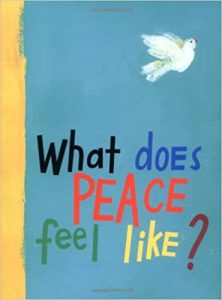Peace

Author(s): Vladmir Radunsky
Links:
Amazon: https://amzn.to/2Ybn9TB
Indigo: https://bit.ly/2uwEjNW
Social Justice focus: Peace
Synopsis: This picture book explores the meaning of peace from the perspective of the senses, using a simile for each. It also provides the word for “peace” in many of the world’s languages.
Lesson Plan: Rachel Sawatsky
Primary/Junior/Intermediate Lesson Plan (Abbreviated Template)
Consecutive and Concurrent Programs
Unit/Topic: Language Arts/Writing
Grade: 4
Lesson: The focus of this lesson is for students to reflect on the peace that different kids around the world experience. Students will have the chance to brainstorm their ideas, turn them into a poem. Afterwards students have to communicate their poem in a different way, into a picture.
Curriculum Areas: Visual Arts
D1.3 use elements of design in art works to communicate ideas, messages, and understandings (e.g., create a poster using colour and cropping of space to propose a solution to climate change; use contour lines of various weights in a charcoal gesture drawing of a person to capture the impression of movement; create a paper sculpture portrait of a favourite comic character that explores positive and negative space, using techniques of folding, scoring, fringing, and crimping)
Curriculum Expectations: Language Arts
A3 Applications, Connections, and Contributions
A3.1 Cross-curricular and integrated learning
D2 Developing ideas and organizing content
D2.1 Purpose and audience
D2.3 Voice
D2.4 Point of view and perspective
D2.6 Editing and proofreading
Learning Goal(s): We are learning to…. reflect on our own experiences and create a 3-line poetry piece and artwork based on our personal reflections.
Success Criteria: I can…. Brainstorm ideas about what peace is to me using the graphic organizer.
I can… Use my graphic organizer to create a 3-line poem about what peace is to me.
I can communicate my ideas/ my poem in a visual manner with art supplies.
MODIFICATIONS / ACCOMMODATIONS:
To meet the needs of students there is a variety of tasks that involve group work, written work, independent work, drawing, and creativity. If a student needs speech to tech software they will have access to that. As well as all students will have access to the book throughout the whole assignment.
Minds-on: Read book “What Does Peace Feel Like?”
Minutes: 5 minutes
Task: I will be reading the book to students and they will listen and look at the pictures.
Assessment: Are students listening? Students graphic organizer that will be created will reflect their listening.
Action Introduce my example of the graphic organizer. Students will create their own graphic organizer (15) with either drawings, words or both. The purpose of this is to get their thoughts out on paper before they know they have to write a poem. This will help the students to have ideas without second guessing them. Students then share their graphic organizer with a peer then with their table group (10). I will then show students a three line poem about what peace is to me. And have them recreate it using their own mind maps. (20 )
Minutes: 45 minutes
Task: I will be introducing the task and walking around seeing if students are first able to work independently, then in groups. I will be looking if students can stay on task.
Assessment: Assessment of Learning. What did students learn from reading the peace book?
Consolidation Students will reflect on their learning by having a discussion about other places that do not experience peace such as some native reserves, or people living in war torn countries. As a class we will come up with these ideas based on what we thought peace was. Asking questions such as do these people experience the same peace as I do
Minutes: 15 mins
Task: I will record the info on a mind map for the whole class to see, as I record info on the mind map I will check off students names who participate in the math lesson.
Assessment: Assessment of Learning. Were students able to relate their own experiences to those of others around them?
MATERIALS:
Arts supplies (markers, crayons, pencil crayons, paper, pens, pencils, rulers, tape, glue, ruler)
Paper for graphic organizers
What does peace feel like book.
Document camera
Anecdotal notes for walking around classroom
Class checklist for consolidation
Rubric For Action Activity
REFLECTION:
- Were my students successful in meeting the learning goals and success criteria? How do I know?
- Did my instructional decisions meet the needs of all students? If not, what are my next steps?
- What worked well and why?
- What will I do differently in the future when teaching this lesson? For the subsequent lesson?
- What are the next steps for my professional learning?

